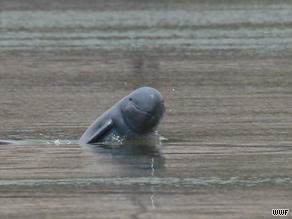
Pollution in the Mekong River in Southeast Asia has pushed the local population of Irrawaddy dolphins to the brink of extinction, the World Wildlife Fund warned Wednesday.
The small freshwater dolphins, distinguished by their round heads and short dorsal fins, are already listed as a threatened species, the WWF said in a report. But analysis of recent dolphin deaths shows their immune systems are suffering because of contaminants in the river, which flows through Cambodia and into southern Laos. “These pollutants are widely distributed in the environment and so the source of this pollution may involve several countries through which the Mekong River flows,” said Verne Dove, a veterinarian with WWF Cambodia who authored the report. “WWF Cambodia is currently investigating the source of the environmental contaminants.” The Mekong River Irrawaddy dolphin population inhabits a 190-kilometer (118-mile) stretch of the Mekong River between Cambodia and Laos, the WWF said. Since 2003, the population has suffered 88 deaths, more than 60 percent of which were calves less than 2 weeks old, the WWF said. Only an estimated 64 to 76 dolphins are in the river, the group said.
Don’t Miss
Contagious cancer threatens devils
Backyard scientists use Web to aid research
Endangered turtles race to save their future
New population of endangered orangutans found
In-depth: Planet in Peril
“Necropsy analysis identified a bacterial disease as the cause of the calf deaths,” Dove said. “This disease would not be fatal unless the dolphins’ immune systems were suppressed, as they were in these cases, by environmental contaminants.” Researchers found toxic levels of pesticides such as DDT and environmental contaminants such as PCBs in the dead dolphin calves. The pollutants also might endanger people along the Mekong who consume the same fish and water as the dolphins, the group said. Researchers also found high levels of mercury in some of the dead dolphins. Mercury weakens the immune system, making the animals more susceptible to disease. The mercury might come from gold mining, the WWF said. The group called for a cross-border preventive health program to manage the diseased animals and reduce their deaths. The International Union for Conservation of Nature has listed the Irrawaddy dolphin on its Red List of Threatened Species since 2004. Mekong River Irrawaddy dolphins are regarded as sacred by Khmer and Lao people, and are an important source of income and jobs for communities involved in ecotourism. More than 60 million people in the lower Mekong basin depend on the river system for food, transport and other economic activity. The river is one of the largest inland fisheries in the world, producing an estimated 2.5 million tons of fish per year, according to the WWF. In some parts of Asia, the dolphins are seen as competitors because they eat the same fish as humans, according to the University of Michigan’s Museum of Zoology. The dolphins can also become entangled in fish nets and damage them. But in other parts of Asia, Irrawaddy dolphins can help fishermen by driving fish into their nets, the university said. The university cited a report of fishermen in Myanmar who attracted the dolphins by tapping the sides of their boats with oars. The dolphins then swam around the boats and forced fish into nets, the university said. The fishermen shared their catch with the dolphins and considered them friends, the university said.
Unlike the more widely known bottlenose dolphins, the Irrawaddy dolphins have a large, round head with no beak. Their dorsal fin — the fin on their back — is smaller and more rounded than their better-known cousins. Irrawaddy dolphins have large flippers, but they are not particularly active and do not leap as high as the bottlenose dolphins, the university said.